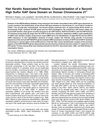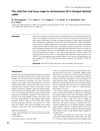Search
for
Did you mean Chromosome?
Learn
2 / 2 resultslearn Osteopontin
signaling protein that, when suppressed, may grow hair by reducing inflammation and stem cell loss
Research
5 / 1000+ resultsresearch Characterization of a First Domain of Human High Glycine-Tyrosine and High Sulfur Keratin-Associated Protein Genes on Chromosome 21q22.1
Researchers mapped and categorized specific keratin-associated protein genes on human chromosome 21q22.1.

research Hair Keratin Associated Proteins: Characterization of a Second High Sulfur KAP Gene Domain on Human Chromosome 21 in Fond Memory of Dr. Peter Steinert
A second domain of high sulfur KAP genes on chromosome 21q23 is crucial for hair structure.

research The Slick Hair Coat Locus Maps to Chromosome 20 in Senepol-Derived Cattle
The gene for slick hair in Senepol cattle is located on chromosome 20 and may involve the SRD5A2 gene.
research A Cluster of 21 Keratin-Associated Protein Genes Within Introns of Another Gene on Human Chromosome 21q22.3
A cluster of 21 keratin-associated protein genes important for hair growth was found on human chromosome 21.
research A New Clinical Variant of Hereditary Localized Alopecia: Report of a Chinese Family Mapped to Chromosome 2p25.1–2p23.2
A new type of hereditary hair loss in a Chinese family is linked to chromosome 2p25.1–2p23.2.
Community Join
5 / 45 resultscommunity Chromosome 20’s balding effects and why fin likely isn’t working for some.
Finasteride is effective for DHT/AR-driven hair loss but not for chromosome 20-driven cases, where treatments like minoxidil, prostaglandin analogs, and low-level laser therapy may be more beneficial. Genetic testing can help determine the underlying cause of hair loss to tailor treatment effectively.
community Why Is No One Talking About Chromosome 20?
Some hair loss may be linked to chromosome 20, which isn't affected by DHT blockers like finasteride. Treatments like minoxidil, microneedling, and genetic testing are suggested, but their effectiveness for this type of hair loss is uncertain.
community Evidenced Based Meta-Analyses and Systemic Reviews of Androgenic Alopecia and Treatments
Evidence-based treatments for androgenic alopecia, such as minoxidil, finasteride, low-level laser light therapy, dutasteride, platelet-rich plasma, and topical ketoconazole. It discusses the efficacy, safety, and mechanism of action of these treatments, as well as future developments in understanding this polygenic condition.
community The Real Cause Of Androgenetic Alopecia
Androgenetic alopecia is caused by DHT affecting hair growth. Finasteride and minoxidil are used to manage hair loss by blocking DHT and promoting hair growth.
community Hair loss and ethnicity - Caucasian men the most likely to experience hair loss
The conversation discusses how Caucasian men are more likely to experience hair loss due to genetic predisposition, with factors like the androgen receptor on the X chromosome playing a significant role. The user also expresses confusion about the evolutionary reasons for hair loss, especially in colder climates where it would seem beneficial to retain hair for warmth.